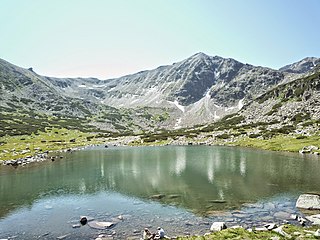
Sofia Province is a province (oblast) of Bulgaria. The province does not include Sofia in its territories, but Sofia remains its administrative center. The province borders on the provinces of Pernik, Kyustendil, Blagoevgrad, Pazardzhik, Plovdiv, Lovech, Vratsa, Montana and "Sofia City Province", and borders with Serbia to the northwest.

Chuquicamata is the largest open pit copper mine in terms of excavated volume in the world. It is located in the north of Chile, just outside Calama, at 2,850 m (9,350 ft) above sea level. It is 215 km (134 mi) northeast of Antofagasta and 1,240 km (770 mi) north of the capital, Santiago. Flotation and smelting facilities were installed in 1952, and expansion of the refining facilities in 1968 made 500,000 tons annual copper production possible in the late 1970s. Previously part of Anaconda Copper, the mine is now owned and operated by Codelco, a Chilean state enterprise, since the Chilean nationalization of copper in the late 1960s and early 1970s. Its depth of 850 metres (2,790 ft) makes it the second deepest open-pit mine in the world, after Bingham Canyon Mine in Utah, United States.

The National Copper Corporation of Chile, abbreviated as Codelco, is a Chilean state-owned copper mining company. It was formed in 1976 from foreign-owned copper companies that were nationalised in 1971.

Kennecott Utah Copper LLC (KUC), a division of Rio Tinto Group, is a mining, smelting, and refining company. Its corporate headquarters are located in South Jordan, Utah. Kennecott operates the Bingham Canyon Mine, one of the largest open-pit copper mines in the world in Bingham Canyon, Salt Lake County, Utah. The company was first formed in 1898 as the Boston Consolidated Mining Company. The current corporation was formed in 1989. The mine and associated smelter produce 1% of the world's copper.

Kennecott Utah Copper LLC’s Garfield Smelter Stack is a 1,215-foot (370 m) high smokestack west of Magna, Utah, alongside Interstate 80 near the Great Salt Lake. It was built to disperse exhaust gases from the Kennecott Utah Copper smelter at Garfield, Utah. It is the 60th-tallest freestanding structure in the world, the 4th-tallest chimney, and the tallest man-made structure west of the Mississippi River.

The Anaconda Smelter Stack is the tallest surviving masonry structure in the world, with an overall height of about 585 feet (178.3 m), including a brick chimney 555 feet (169.2 m) tall and the downhill side of a concrete foundation 30 feet (9.1 m) tall. It is a brick smoke stack or chimney, built in 1918 as part of the Washoe Smelter of the Anaconda Copper Mining Company (ACM) at Anaconda, Montana, in the United States. A terra cotta coating covered the entire brick chimney when new, but by the time the smelter closed in 1981, most had eroded away except for the upper 40%, exposing most of its bricks and reinforcing rods. The inside diameter at the bottom of the brick chimney is 76 feet (23.2 m) while that at the top is about 60 feet (18.3 m). The stack and its viewing area are now the two-part Anaconda Smoke Stack State Park.

The Bingham Canyon Mine, more commonly known as Kennecott Copper Mine among locals, is an open-pit mining operation extracting a large porphyry copper deposit southwest of Salt Lake City, Utah, in the Oquirrh Mountains. The mine is the largest man-made excavation, and deepest open-pit mine in the world, which is considered to have produced more copper than any other mine in history – more than 19,000,000 short tons. The mine is owned by Rio Tinto Group, a British-Australian multinational corporation. The copper operations at Bingham Canyon Mine are managed through Kennecott Utah Copper Corporation which operates the mine, a concentrator plant, a smelter, and a refinery. The mine has been in production since 1906, and has resulted in the creation of a pit over 0.75 miles (1,210 m) deep, 2.5 miles (4 km) wide, and covering 1,900 acres. It was designated a National Historic Landmark in 1966 under the name Bingham Canyon Open Pit Copper Mine. The mine experienced a massive landslide in April 2013 and a smaller slide in September 2013.
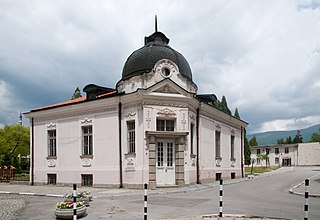
Pirdop is a town located in central-west Bulgaria in Pirdop Municipality of Sofia Province in the southeastern part of the Zlatitsa–Pirdop Valley at 670 m above sea level. It is surrounded by the Balkan Mountains to the north, Sredna Gora mountain range to the south, and Koznitsa and Galabets saddles to the east and west, respectively. The town has a population of 6,739 as of 2022.
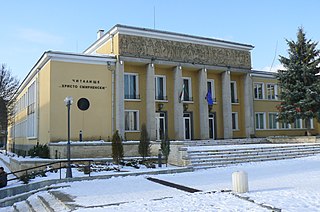
Zlatitsa is a town and the seat of the Zlatitsa Municipality in southern Bulgaria located in the Zlatitsa–Pirdop Valley. It lies between Stara Planina to the north and Sredna Gora to the south at 680 metres (2,230 ft) above sea level. It is situated immediately south in the lap of the Zlatitsa-Teteven Mountain. Zlatitsa is situated 75 kilometres (47 mi) east of Sofia, 27 kilometres (17 mi) south of Etropole, 32 kilometres (20 mi) north of Panagiurishte, 2 kilometres (1.2 mi) west of Pirdop and 32 kilometres (20 mi) northwest of Koprivshtitsa. The population is 5,286.
Asarel Medet is a Bulgarian company extracting and processing copper. The mine and the processing factory are situated at 11 km to the northwest of the town of Panagyurishte in the Pazardzhik Province, Bulgaria. It extracts over 13 million tons of copper ore every year and produces copper concentrate which is sold worldwide, including to the Pirdop copper smelter and refinery at about 25 km north of Panagyurishte. The ore also contains molybdenum, nickel, gold, silver. The number of employees is 1,200, not including 400 hired in its subsidiaries. In addition, the company attracts 6,400 indirect jobs in the region and nationwide in different related services. It is the largest employer and taxpayer in Pazardzhik Province. Asarel Medet produces copper concentrate and cathode, mainly used as raw materials for copper smelters and partially for the chemical and ceramics industry. The company produces about 200 thousand tons of natural copper concentrate annually with 25% copper grade.
Mount Isa Mines Limited ("MIM") operates the Mount Isa copper, lead, zinc and silver mines near Mount Isa, Queensland, Australia as part of the Glencore group of companies. For a brief period in 1980, MIM was Australia's largest company. It has pioneered several significant mining industry innovations, including the Isa Process copper refining technology, the Isasmelt smelting technology, and the IsaMill fine grinding technology, and it also commercialized the Jameson Cell column flotation technology.

Bulgaria is an industrialized nation with a developed heavy and light manufacturing industry. In 2007 industry accounted for 31.7% of the country's GDP. This makes industry the second-largest sector of the economy after services. In 2007, the sector employed 33.6% of the labour force.
On 17 December 2008, Cumerio and Norddeutsche Affinerie AG (NA) became Aurubis - Europe's biggest copper producer.
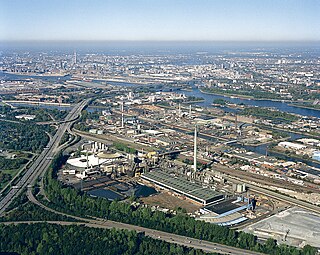
Aurubis AG is a global supplier of non-ferrous metals and one of the world's largest copper recyclers. The company processes complex metal concentrates, scrap, organic and inorganic metal-bearing recycling materials and industrial residues into metals. Aurubis produces more than 1 million tons of copper cathodes per year and from these a variety of products such as wire rod, continuous cast shapes, profiles and flat rolled products in copper and copper alloys. Aurubis also produces a range of other metals, including precious metals such as selenium, lead, nickel, tin and zinc. The portfolio also includes other products such as sulfuric acid and iron silicate.
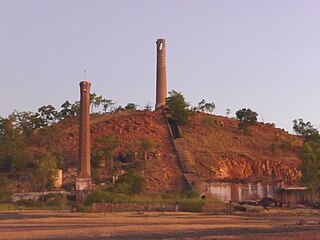
The Chillagoe smelters is a heritage-listed refinery at Chillagoe-Mungana Caves National Park, Mareeba Mining District, Chillagoe, Shire of Mareeba, Queensland, Australia. It operated in the early 1900s. It is also known as Chillagoe State Smelters. It was added to the Queensland Heritage Register on 21 October 1992.
Mopani Copper Mines PLC is a Zambian company that produces and sells copper and cobalt to the international market, being one of the biggest mines and exporters in the world.

OK Mine & Smelter is a heritage-listed mine at Kitoba Holding, Bellevue, Shire of Mareeba, Queensland, Australia. It was built from 1902 to 1942. It was added to the Queensland Heritage Register on 2 October 1996.

Kuridala Township site is a heritage-listed mining camp in the locality of Kuridala, Shire of Cloncurry, Queensland, Australia. It was built from 1880s to 1920s. It is also known as Hampden Township, Hampden Smelter, Kuridala Smelter, and Friezeland Township. It was added to the Queensland Heritage Register on 12 June 2009.
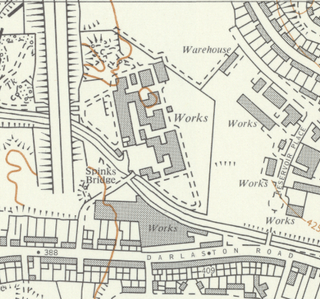
The James Bridge Copper Works was a copper refining plant in Walsall, Staffordshire, England. It was established as a smelting plant in 1917 on a site formerly used for ironstone and coal mining and as a brickworks. From 1920 it was owned by the Wolverhampton Metal Company who expanded the works. It was temporarily closed in 1931–2 because of local pollution issues and during the Second World War due to blackout regulations. After the war the plant specialised in reclamation of copper from waste materials and became a leader in that field, helping to alleviate a national shortage of copper; by 1964 the plant had electrowinning facilities. The works were purchased by Imperial Metal Industries Limited in 1967 and the electrowinning facilities were greatly expanded over the following decades. The site closed in 1999.

Zlatitsa–Pirdop Valley is situated in central western Bulgaria and is the fifth of the eleven Sub-Balkan valleys in direction west–east. It is named after the two towns that lie within, Zlatitsa and Pirdop. The valley is an important hub of the Bulgarian copper and gold mining and processing industry. It contains numerous natural and architectural landmarks, including the ruins of the late Roman Elenska Basilica.
















